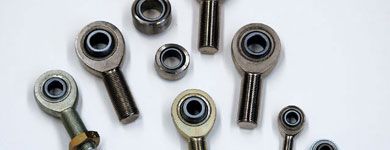
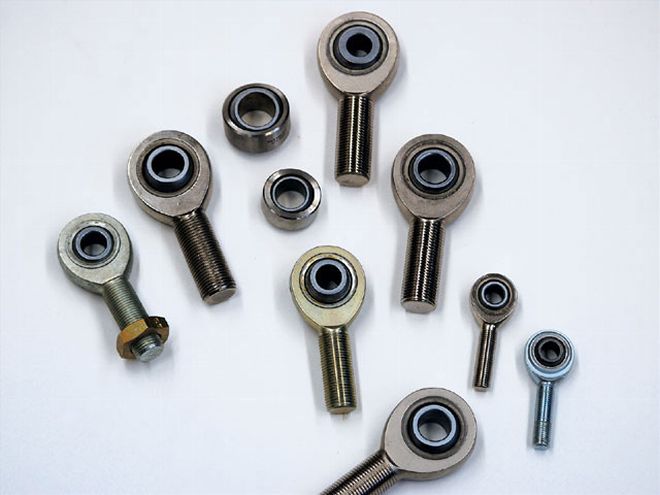
Inside today's street rod, no matter what style, there's a good chance you'll find at least a couple of rod ends, spherical bearings, or, as the Brits sometimes call them, rose joints. Rod ends happen to be one group of components that receives little attention or no added thought. After all, they all appear much the same, and they're pretty much forgotten when they're hidden deep inside the bowels of a hot rod. Unfortunately, rod ends may be one of the most critical hardware pieces on any modified car-street rod or otherwise-and they're components you shouldn't forget about.
Most rod ends are regularly used in places where they're given the task of handling sizeable loads, and there is usually no backup-it's the rod end versus the load. Needless to say, it spells big trouble if a rod end breaks in a suspension or steering component, which is instantaneous. Because of this, rod ends are absolutely critical, and some are truly aerospace quality while others are nothing more than junk, with plenty of different examples in between. Simply looking at a rod end is even more perplexing, since it's difficult to differentiate between a good-quality rod end and one that's more qualified for scrap.
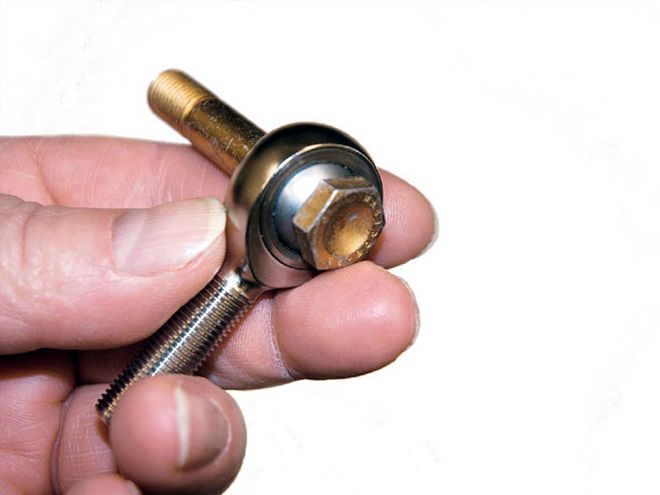 This is a three-piece ("aircraft") rod end. With this configuration, the race is formed around the ball, and then the race insert is staked into the body.
This is a three-piece ("aircraft") rod end. With this configuration, the race is formed around the ball, and then the race insert is staked into the body.
The Bare Bones Of Rod-End ConstructionA rod end consists of a spherical ball designed to rotate inside a housing; this ball is the actual bearing, while the housing wrapped around it is the race. The spherical ball has a machined flat on each side, and this modified "sphere" is bored with a hole through the center. That's the bare bones of rod-end construction, but there's more. When scouring the marketplace for rod ends, you'll regularly find "economy" or "commercial" examples.
While there are a number of different economy rod ends available, this is where most of the pretenders come into play, so the only types you should even think of using are the fully formed-or, more correctly, "swaged"-two-piece examples. During manufacture of these rod ends, the body is swaged around the ball so the race on which the ball rides is actually part of the body. If you're checking out lower-cost rod ends for your rod, this is the only configuration that offers reasonable radial or pull-strength coupled with good axial strength, which is the resistance of the ball being pushed out of the side of the body.
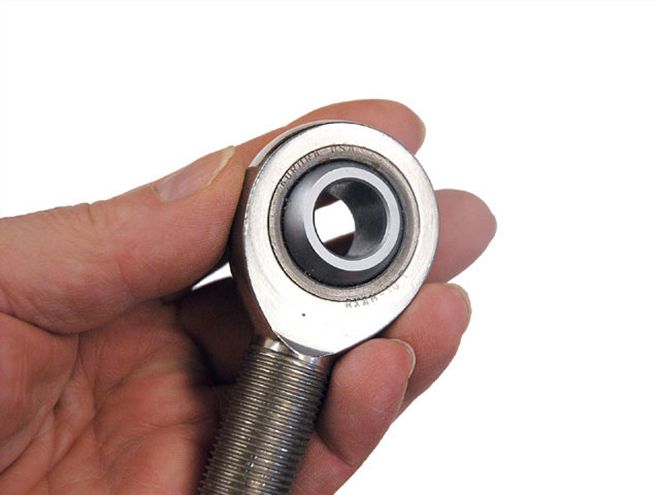 Different materials can be engaged in construction because of the three-piece design. This process allows the rod end to best match the application (strength versus load).
Different materials can be engaged in construction because of the three-piece design. This process allows the rod end to best match the application (strength versus load).
Ultimate high-performance rod ends use a three-piece precision layout. Here, the race is formed around the ball, and then the race insert is staked into the body. With this type of manufacture, a much closer fit along with a much higher degree of precision between the ball and the race is provided. Regularly, this three-piece configuration is referred to as an "aircraft" rod end. The three-piece design provides for different materials to be used during the manufacturing process, allowing the rod end to best match the application. Races can be constructed of mild, alloy, or stainless steel-brass or aluminum bronze is sometimes used, but the truth is, it should be avoided because of the low strength. Meanwhile, bodies are constructed from mild, alloy, or stainless steels, aluminum, or even titanium.
Material WorldAs pointed out earlier, there is a wide range of materials used in the construction of rod ends. Typically, the balls are subjected to the highest loads encountered by the rod end, and, because of this, they require the greatest hardness and of course, the greatest ultimate strength. Certain inexpensive commercial rod-end balls are manufactured from bronze or even sintered steel materials. From a strength perspective, these materials aren't so appropriate, but there's a big caveat: Certain sintered steels are fully up to the job. For example, respected German automobile manufacturer BMW has started using sintered steel for high-stress applications, such as connecting rods. With the right heat treat, sintered steels can live happily in a medium-duty rod-end ball application. Of course, high-quality rod ends normally incorporate heat-treated steel balls, regularly using chrome-moly, stainless, and 52100 bearing steels. The balls must be extremely hard so they remain round, and they are chrome-plated to provide a smooth bearing surface in many cases, which is vital when the ball is placed under a load.
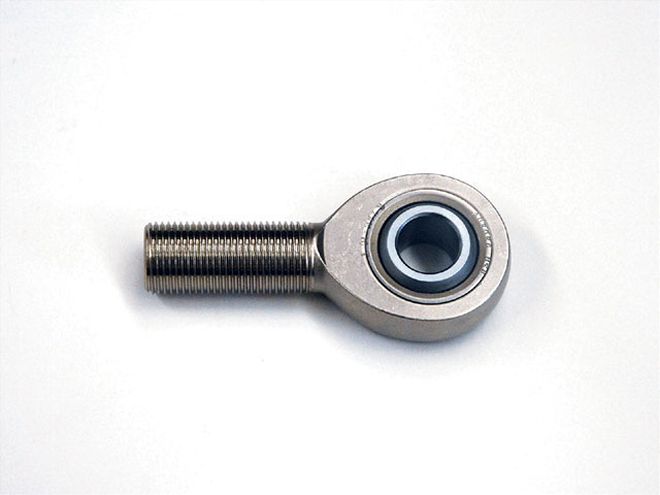 This rod end has a composite Teflon liner, and two- or three-piece rod ends with Teflon liners can be purchased.
This rod end has a composite Teflon liner, and two- or three-piece rod ends with Teflon liners can be purchased.
Due to the heat treat and overall hardness of the ball, the outer rod-end race must be hard, but not as hard as the ball. Many three-piece rod ends incorporate a race manufactured from through-hardened steel alloy or a stainless steel. In both of these examples, the outer race is heat-treated for wear resistance, and, of course, for strength.
Economy rod ends, on the other hand, usually have bodies constructed from low-carbon mild steels, and it isn't possible to through-harden this material. Although this less-costly material might function perfectly well in a lightly loaded application, rod-end bodies manufactured from chrome-moly or heat-treated stainless steel are far superior in severe-duty applications. The use of chrome-moly or stainless bodies allows the physical size of the rod end to be reduced because the material has more strength. Some manufacturers offer rod ends with bodies manufactured from 7075-T6 aluminum, which is one of the strongest grades of aluminum, and it actually has a tensile strength slightly greater than mild steel. If you compare two similarly designed rod ends, one made from mild steel and the other from 7075-T6, you'd end up with similar strengths. The truth is, aluminum is not as forgiving as mild steel under analysis, since it will not stretch or bend as much before breaking. You'll discover the steel jobs have almost double the strength when a comparison is made between the strength of an aluminum rod end to the strength of a heat-treated chrome-moly or stainless component.
 Examine this rod end closely. See how the ball isn't centered? This is the misalignment that the rod end design can handle.
Examine this rod end closely. See how the ball isn't centered? This is the misalignment that the rod end design can handle.
Ultimately, use high-quality heat-treated steel examples, unless you have a very good handle on the limitations of aluminum rod ends, and you're absolutely certain with regard to the loads encountered. The safety margin is much greater.
Teflon LubricationThe Teflon liner is a very common option seen on rod ends, as it allows the rod end to be self-lubricating, and this liner is important, since it's usually rather difficult to grease or oil a rod end once it's installed on a car. Rod ends with a grease fitting are not a good idea, since the grease fittings can physically weaken the rod end, and grease on the rod-end ball also attracts grit that works its way between the ball and race, ultimately accelerating the wear process.
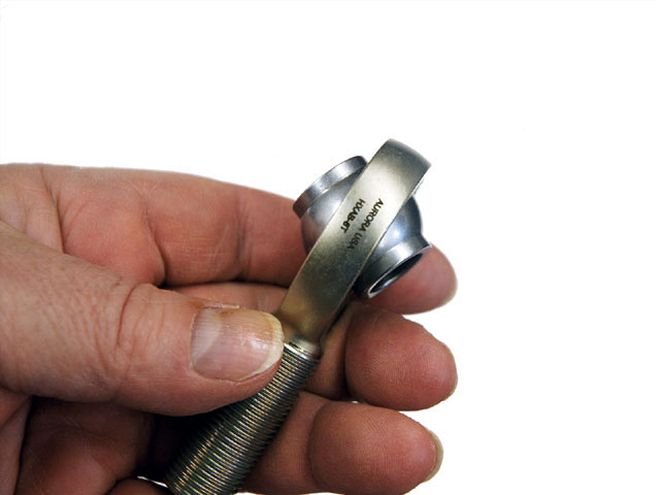 Misalignment is the degree of angular movement a ball can accommodate without interference. This is a special "high misalignment" bearing offered by Aurora (note larger shoulder).
Misalignment is the degree of angular movement a ball can accommodate without interference. This is a special "high misalignment" bearing offered by Aurora (note larger shoulder).
The use of a Teflon liner cures most, if not all, of these ailments and consists of a carrier component-often a fabric that provides compressive strength-a Teflon component for lubricity, along with various bonding resins. The Teflon liner is bonded to the race so the ball actually rides on the liner. The movement of the ball rubs Teflon on the ball, which, in turn, provides lubrication. Rod ends with Teflon liners are manufactured in two- or three-piece configurations; beware of inexpensive rod ends manufactured with virgin Teflon. This material is relatively soft with a compressive strength of approximately 10,000 psi. On the other hand, a high-quality composite Teflon liner will have a compressive strength of somewhere between 40,000 and 60,000 psi, and a quality Teflon liner eliminates clearance between the ball and race, resulting in a much tighter fit.
Simply adding a Teflon liner to a rod end doesn't ensure precision nor performance. When researching rod ends, a term you'll encounter is "beating out," which refers to a couple of distinct problems. The first is the deformation of low-strength, self-lubricating liners. Certain economy rod ends are built with races constructed from molded plastic, which are occasionally mixed with a fiberglass filler, and Teflon may also be added for lubricity. These low-buck rod ends have a compressive strength of no more than 15,000 psi, and, under load, this causes the race to deform long before the body encounters any damage.
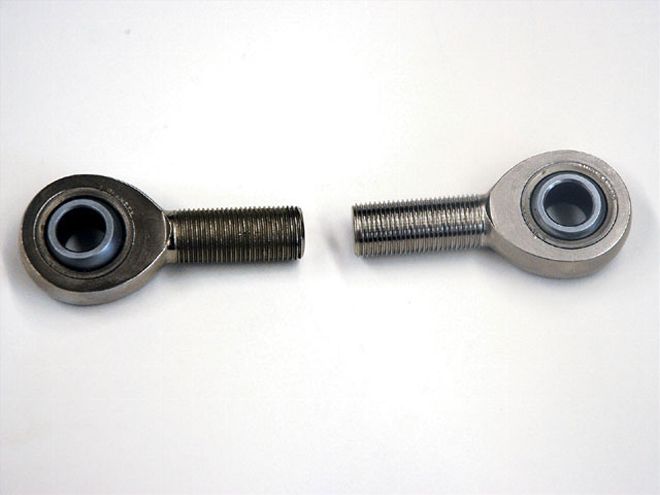 Rod ends are usually available with left- or right-hand threads. For something like as a trailing arm-a four-bar, a four-link, and the like-simply order the appropriate bearing.
Rod ends are usually available with left- or right-hand threads. For something like as a trailing arm-a four-bar, a four-link, and the like-simply order the appropriate bearing.
Another type of liner beating-out failure involves the physical bond between the liner and the race. Due to the self-lubricating nature of the liner, it is occasionally difficult to make the bond to the race; the liner will become detached from the race if this bond isn't sufficiently strong. Each time there is a misalignment of the rod end, which we will touch on more later, tiny portions of the liner disintegrate, and, over time, the clearances will prove excessive. Aside from government MIL specs for Teflon-lined bearings, there are no standards set for liner bond strength, so you basically have to trust the integrity of the manufacturer.
Aligned Or Misaligned?
How can something as simple and straightforward as a rod end be misaligned? Go back to the "bare-bones basics" description of rod-end construction (sphere inside the race). A bolt or some other form of fastener goes through the hole bored through the center of the rod end, so it's obvious the sphere or ball cannot rotate inside the housing a full 360 degrees because of this; of course, without the fastener through the center, the ball can rotate through a full circle. Due to this, all rod ends have specific limitations with regard to how far they can be misaligned before the sphere binds in the housing. This angle of misalignment is an important factor when choosing rod ends for a specific application, since not all rod ends can accept the same degree of misalignment as others. If you exceed the manufacturer's recommended maximum misalignment angles, the least worrisome thing you'll discover is premature rod-end wear; however, the worst thing you'll encounter is outright rod-end failure, which, of course, isn't good.
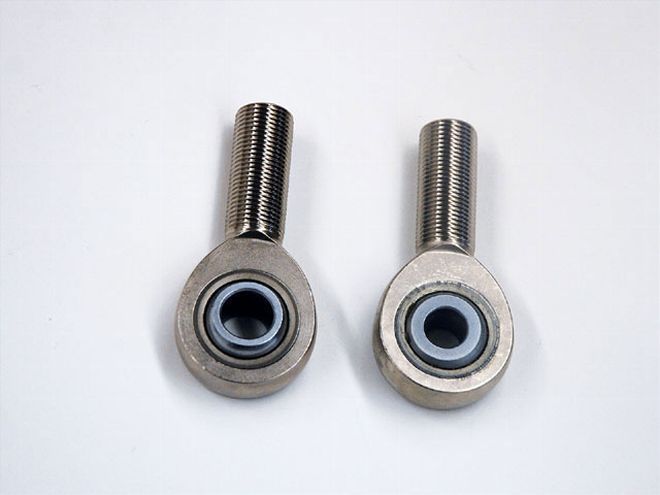 The rod end on the left is a standard job, while the rod end on the right is a heavy-duty model. The HD model has a 5/8-inch bore while the standard version has a 3/4-inch bore.
The rod end on the left is a standard job, while the rod end on the right is a heavy-duty model. The HD model has a 5/8-inch bore while the standard version has a 3/4-inch bore.
The good news is, it's not that tough to figure out these misalignment angles. Use a good old-fashioned protractor to dimensionally check the geometry, and you'll also discover that various angles of misalignment are specified in most rod-end catalogs-at least in those by manufacturers who build quality rod ends. If you compare your measured angles to those in the catalog, you'll be able to choose the right rod end for the application. And, don't be tempted to shortcut the measurement job by purchasing a rod end that simply looks big enough to handle the job-it will come back to haunt you.
Size MattersDimensionally, a rod end can be constructed one of two ways. The first type incorporates a shank, the threaded segment, that is exactly the same diameter as the hole in the ball-as an example, a 5/8-inch bore coupled with a 5/8-inch shank. The second configuration has a shank that is one size larger than the bore, a common example being a 5/8-inch bore mated to a 3/4-inch shank. The second type-small bore, large shank-is advantageous, particularly where bending loads may be present. A good example is a pro drag-race four-link. In this example, there are two pairs of tubular bars acting as levers, transmitting considerable forces from the chassis to the tires, and vice versa. The large shank provides more outright strength along with a big chunk of reserve strength capacity, while an oversize shank is generally constructed by installing an insert one size smaller in the body of a rod end with the larger shank. Due to this, a 5/8x3/4-inch rod end will always exhibit greater load capacities than a 3/4x3/4-inch rod end, provided both are manufactured from similar materials. The reason for this is because there is more body material around the insert. Asymmetrical rod ends such as this also provide superior wrench access on many suspension components, simply because the fastener that goes through the center of the rod end is smaller. An exception to the above is where a rod end with a larger shank is added to a smaller body. Although this configuration serves the same purpose as the oversize shank mentioned above, it provides less beef around the rod-end ball.
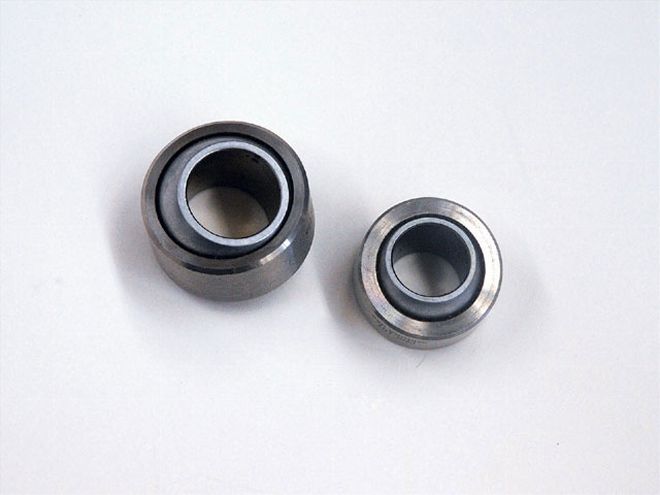 Spherical bearings are close relatives of rod ends, and they have countless uses in cars. We've used them in OEM control arms, custom trailing arms, and so on.
Spherical bearings are close relatives of rod ends, and they have countless uses in cars. We've used them in OEM control arms, custom trailing arms, and so on.
Clocking Rod EndsThe orientation of the rod ends on either end is important when a pair of rod ends is used in a single component, such as a four-link bar. This is called "clocking," but before we examine that, we should point out that even very small adjustments in any suspension link that sees preload could make a great difference in the way the car handles. In some cars, one-sixth of a turn at a time is sufficient to see a change in the behavior of the chassis. Because of this, it's a good idea to use the flats, or flat sides, of the jam nuts as a reference point for adjustment.
Here's how this small adjustment process works: In Illustration 1 on the facing page, you can see how a typical link is configured. One side is equipped with right-hand threads while the other end of the link is equipped with left-hand threads, and you can lengthen or shorten the entire link by loosening the jam nuts.
Check out Illustration 2 for clocking. As you can see, when the rod ends are properly clocked, they're aligned. This prevents binding of the suspension and makes it easy to determine if the link is under tension by feel, meaning you can tell if the link is neutral or under strain if you grasp the link by hand, and rotate it back and forth.
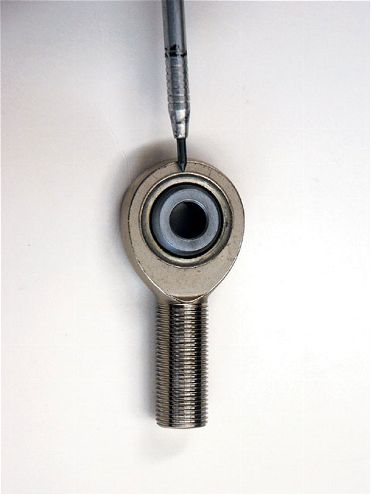 Here's a close-up of a heavy-duty rod end. The oversize rod end is generally made by installing an insert one size smaller in the body of the part with the larger shank.
Here's a close-up of a heavy-duty rod end. The oversize rod end is generally made by installing an insert one size smaller in the body of the part with the larger shank.
Finite Life And Junkyard Dogs
Say you pick up a coffee can full of "lightly used" rod ends at the local swap meet. You've scored, right? Probably not. You see, just like any other piece of hardware, a rod end has a finite mechanical life, and there is no way of knowing if a used or surplus rod end has reached the end of its life cycle. Equally important is the fact that there is no safe way to repair or "tighten" a worn bearing. And, remember, any rod end that demonstrates any amount of stretching in the threads or in the head should be discarded. The same applies to any rod end bearing that has been dented in the race area or is bent-they've definitely met their end.
The reality is, from 2 feet away, it's almost impossible to tell a junk rod end from a high-quality piece. The only thing you can do is examine each rod end in the same manner as you'd look at any precision piece of hardware-take a close look at the machining, examine the race, and scrutinize the ball (sphere). Are they well machined and smooth in each case? If the rod end is a non-Teflon configuration, does the ball fit inside the body precisely? Rotate the ball. Is there any bind or is it so loose it rattles? Inspect Teflon liners, and look for areas where the liner is loose, since the liner should be one continuous, tightly bonded piece. When observing the threads, they should be high-quality rolled threads, just like a good bolt or capscrew. The rod-end evidence is right there in front of you, so use it to help decide what's hot and what's not.
As you've probably come to expect, good-quality rod ends cost good money. The very best rod ends are those designed and built by way of proper engineering and then backed by rigorous research, development, and testing programs. The reality is, you're buying a precision mechanical component, and it's one into which you have to put your trust and safety. And, given the magnitude of tasks with which rod ends are charged, they really amount to critical mass.